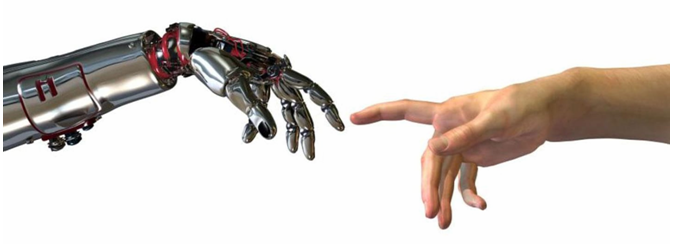Evolution of the intellect: the beginning

The achievements of robotics and, especially, the costs of them * made the idea quite obvious that not only one person has intelligence, that not only domestic animals with which we are more or less familiar, but even unicellular organisms, have it.
Estetu note: * The idea that a rocket worth a million dollars can be missed on a target, and a sperm cell that does not cost anything at all - no - it can shock VPK representatives (s) A. Rozov
It turns out that human intelligence can be viewed not as something exclusive, as previously thought, but rather as a new generation in a series of models of intelligence from the workshop of nature.
Therefore, in order to study the intellect of man, it would be nice to understand not only himself, but also the whole path traveled by nature. The proposed original evolutionary classification of intelligence by generation (or evolutionary levels) will clarify the milestones of this path.
Anyone who is interested in the topic, please under the cat.
Formulation of the problem
The question that needs to be solved when setting the task: why do we even need to know how a person's intelligence appeared, became more complicated and finally became the way it is?
The most obvious answer is: in order to see how everything happened in the nature workshop, to make its likeness - artificial intelligence (AI).
In fact, we are very positive about AI to a certain level of intellectuality: as a person’s liberator from routine work. Let the robots sort out the potatoes, pour the beer into bottles, close them with lids, screw the nuts and lead us to a bright future filled with creative work and blissful idleness.
When we encounter higher manifestations of the intellect, an alarming attitude appears. Even at the design stage of the robot driver, an ambiguous relationship arises, and right at the stage of setting the task: “If an emergency, desperate situation arises, what to choose? To move a car a group of people, one pregnant woman or a child standing alone? ”
When this happens to a person, it is a tragedy, he will dream about killed people, he will suffer, even if there is no fault on him. And these tortures to some extent in our eyes justify what happened. The robot driver will choose the option absolutely unemotional, soullessly weighing life on the scales of the matrices and calculating the minimum damage by the method of speedy descent (well, or another mat.methodom) and this scares us.
Let's admit that emotions are important to us, without them we will not be able to take highly intelligent robots into our community. And where did the emotions come from? We know that animals also have emotions: domestic animals, certainly. We see that they are happy, sad, angry, jealous, jealous, sad and indignant - just like us.
And yet, why do we need highly intelligent robots in general? For work in places that are dangerous and inaccessible to humans (Mars is the planet of robots, sic!), For solving problems that are difficult to reach for humans due to biological limitations (primarily, fatigue). After all, the driver-robot is also being done precisely because a tired person, going home after work, is a potential source of an accident.
And finally: the economy has become so complex that its management begins to exceed any conceivable possibilities of one person. And the decision through the management of a group of people, unfortunately, is not additive, that is, even if we assume that 2 people will do 2 times more work, then 1000 people will definitely not do 1000 more.
Estetu note: "Figvam" Sharik and Matroskin - an excellent example of how 2 individuals can work collectively worse than one.
Any group of people, which is proved statistically reliable, spends more time on relationships with each other instead of working. Repeatedly conducted experiments showed that the dismissal of a significant part of the employees of the bureaucratic structure did not impair its work in any way, and it even improved.
Estetu note: "Growth leads to complexity, and complexity - it's the end of the road" (c) Parkinson's laws. S. Parkinson
We note that we are very approving of robots, who, through the Internet, accept applications from us to the bureaucratic authorities and send inquiries, call us taxis and reserve hotel rooms, completely replacing entire classes of service provision.
As a result, we are witnessing the emergence of more and more highly intelligent robots. Obviously, this process is inevitable and will continue.
Estetu note: If the process can not be stopped, it is worth to lead (s). author unknown
However, in order to lead a process, it is highly desirable to understand its history and have some kind of prediction for the future. All this makes the theory of intelligence evolution in demand, which will logically explain to some extent how the intellect developed and how it reached its modern peak in the form of human intelligence and what will happen next.
Classification of generations of intelligence
As we can see, human intelligence is qualitatively different from the intelligence of a pet. The cat will not order pizza, will not clean the house, does not even walk the dog because he has paws. This is just technically surmountable, you can easily come up with a robotic interface for a cat.

Let's assume that the level of intelligence is directly related to individualization. This will allow us to enter 4 + 1 levels or generations of intellects.
Zero individualization has an intelligence that consists entirely of algorithms. Algorithms (or in other words: program code) are unchanged and the individuality of their carrier (computer or animal) will differ only in technical integrity.
The first level of individualization of living beings gives reflexes. This is a well-studied phenomenon and reflexes are divided into conditioned and unconditioned. The first level of individualization is, of course, unconditioned reflexes. The evolution of living beings is due to mutations that provide individual variability. Each individual has a slightly different structure of the neural network that provides the performance of the reflex, and the habitat will make sure that the unsuccessful variants do not survive and do not give offspring with a similar network structure.
The second level of individualization is conditioned reflexes. The principal difference is that the reflex is not fixed forever, but may change during the life of one individual. Thus, the degree of individualization is greatly expanded.
The third level of individualization is communicative. The main innovation of the level is the ability to trigger a reflex through a conditional information signal. Individualization is further expanded through the volume of individually perceived and generated sequences of communication signals. Intelligence carriers can leave solitary lives and become able to form flocks and begin to coordinate their actions. Moreover, the possibility of interspecific information interaction appears and is actively used.
And finally, the fourth level is abstract logical. This is the level of man. Communication turns into speech. Culture appears as a sum of knowledge independent of an individual, but at the same time potentially accessible to everyone. Individualization reaches a potentially infinite level.
Results
Let us summarize the characteristics of the generations of intelligence in a table for greater convenience of understanding.
| Signs of | ||
|---|---|---|
| Null | Only algorithms | Constant behavior for the whole species. |
| I | Algorithms + unconditioned reflexes | Behavior varies slightly within the same species, but invariably throughout the individual’s individual life. |
| II | Algorithms + conditioned reflexes | Behavior varies within the same species and adaptively changes during the individual life of the individual. |
| III | Algorithms + conditioned reflexes + communication | The ability to generate and perceive conditional information signals, the emergence of interspecific information interaction |
| IV | Algorithms + conditioned reflexes + communication + | Speech and culture |
What gives such a classification? And why is it better than many others? The answer to these questions can be read in the next article “Robots and Emotions”, in which, already based on the classification introduced, the mechanism of the appearance of emotions, their significance and why robots and we humans need them will be considered in detail.
Thanks and invitations
The author thanks Professor N.V. Khamitov for the invaluable assistance provided during the development of this theory.
The author invites everyone, especially evolutionary biologists, to participate in the discussion, and maybe, being carried away, to join the work on the theory.
')
Source: https://habr.com/ru/post/447448/
All Articles